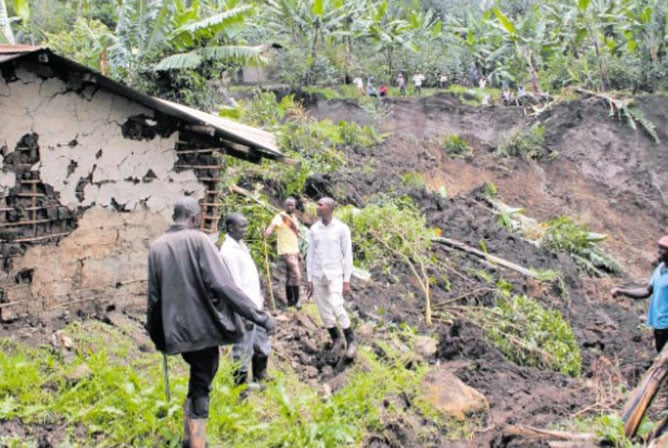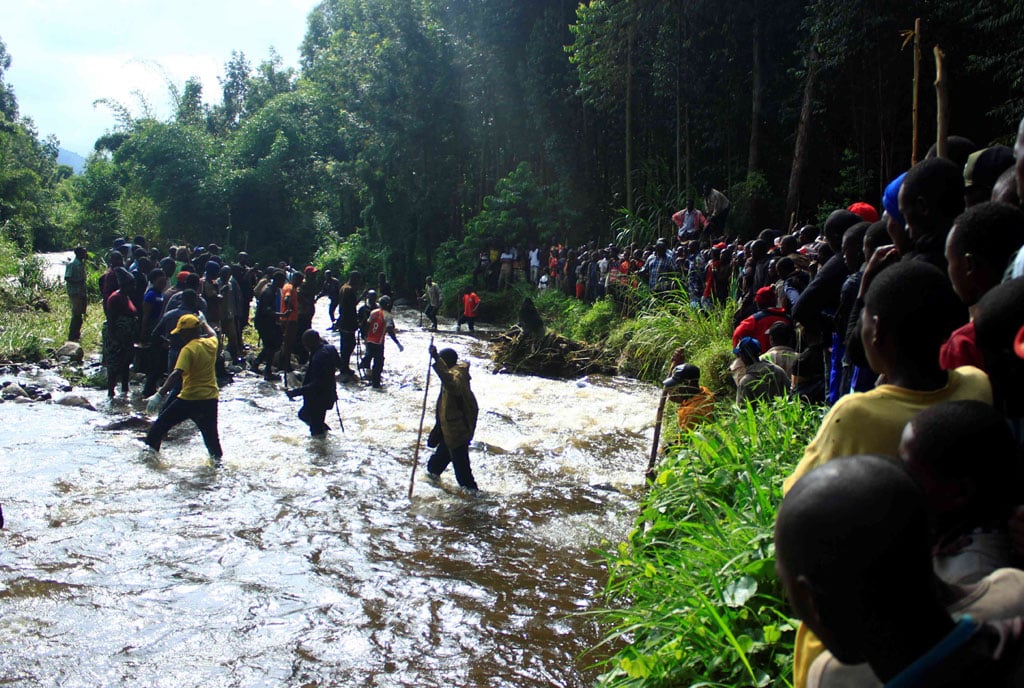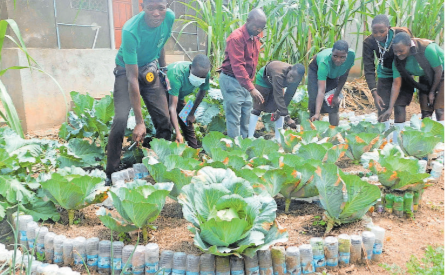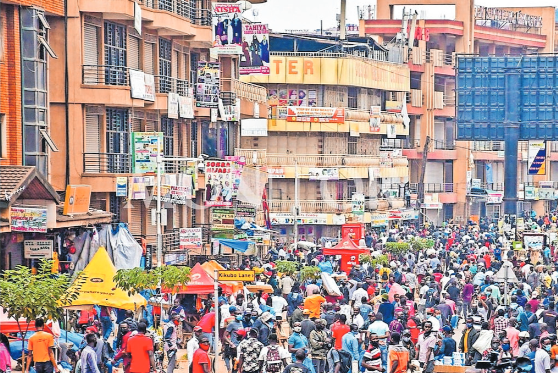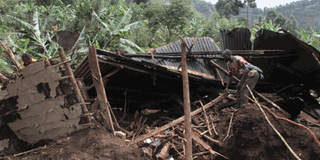
Locals at a landslide scene where a house was buried in Nambekye village in Bulambuli district. PHOTO BY DAVID WANDEKA
Uganda has been experiencing more erratic rainfalls resulting in frequent busting of rivers, mudslides and landslides that lead to not only loss of lives but also ravage farmland.
Uganda is projected to see droughts of heightened frequency, intensity and duration by 2030, barely six years away, severely affecting productivity in growing areas for temperature sensitive crops such as coffee and tea – two leading foreign exchange earners for the country, Prosper Magazine has learnt.
As this plays out, Prosper Magazine has also established that the climate change financing environment is also changing as evidenced by the dwindling funds meant for adaptation and mitigation measures. It is estimated that climate change and related project financing will drop from $400 million to about $300 million by the close of this year, with some analysts saying it could drop even further.
The findings contained in the Climate and Fiscal Justice Scoping Study, corroborate the aforementioned fear laid bare by climate researchers and scientists who highlight the urgent need for enhanced, equitable climate finance to support the communities in Uganda most affected by climate change.
Last week, while disseminating the report from a collaboration between Oxfam in Uganda and the Advocates Coalition for Development and Environment (ACODE), it became clear that there is a mismatch between funding meant for climate change interventions and direct impact on the communities and lives of those facing the brunt of harsh shifts in weather and related conditions.
Uganda stands at the frontlines of the climate crisis.
“Many communities, especially those in vulnerable areas like Mount Elgon region and Kasese, are already feeling the severe impacts of climate-related disasters, experiencing both environmental degradation and socioeconomic losses. Yet efforts to support communities to cope better are still lean,” the country director of Oxfam in Uganda, Mr Francis Shanty Odokorach, said while introducing the report last week in Kampala.
He continued: “There is uncertainty around the adequacy of public finance management systems to respond to climate change in terms of equity-responsive budgetary allocation and tracking of climate finance.
“Equally important is whether richer countries are honouring their legal obligations in channeling climate finance to low-income countries in line with Article 9 of the Paris Agreement.
Ranking
Uganda is ranked 12th most vulnerable to climate change out of 192 countries and is one of the least prepared, ranking 163rd out of 192 countries in terms of readiness to deal with the climate crisis, according to Notre Dame Global Adaptation Initiative (ND-GAIN) Country Index which summarises a country's vulnerability to climate change and other global challenges in combination with its readiness to improve resilience.
Despite the severe threat posed by climate change and the accompanying loss and damage it brings, the Climate and Fiscal Justice Scoping Study, reveals that uncertainty around the adequacy of public finance management systems to respond to climate change budgetary allocations and tracking of climate finance is wanting.
Coincidently, richer countries no longer seem optimistic in honouring their legal obligations of channeling climate finance to low-income countries such as Uganda in accordance with Article 9 of the Paris Agreement.
“It is evident that the current scale of financing falls short of the challenges at hand and requires urgent intervention to support low-income countries that are already grappling with the dire effects of climate change,” says Mr Odokorach.
Lagging behind?
Although some $400 million (about Shs1.5 trillion) found its way into the country last year under climate financing, a review of climate finance inflows to Uganda’s regional peers such as Kenya and Ethiopia indicates that Uganda still lags in attracting adequate funding. The Climate and Fiscal Justice Scoping Study attributes this to capacity gaps such as the preparation of bankable project proposals aligned to different climate finance funding mechanisms.
Additionally, comparisons between climate finance inflows reported by global organisations such as the OECD and those reported by the Government of Uganda show big differences. This is partly due to what the report indicates as a subjective interpretation of what constitutes climate finance, different methodologies and the inadequacy of government systems for tracking and reporting off-budget climate change projects implemented with direct support from development partners and non-state actors.
For Uganda to achieve her updated economy-wide mitigation target of reducing emissions by 24.7 percent by 2030 (Nationally Determined Contributions) – an ambition for combating climate change, it is estimated that it will cost $28.1 billion over five years.
Uganda has committed to mobilise domestic resources to the tune of $4.1billion to cover an estimated 15 percent of the total cost, while the remainder of $24 billion which is about 85 percent will be sought from intervention sources in line with Article 9 of the Paris Agreement.
This, according to Dr Mugeere Buyinza Anthony, a climate change researcher, implies that achieving the aforementioned targets is dependent on compliance with climate justice principles by higher-income countries honouring their pledges.
For now, Dr Mugeere who is also a research fellow at ACODE, a public policy think-tank based in Kampala, while presenting the Climate and Fiscal Justice Scoping, reveals that while national frameworks such as the Certificate of Climate Change Responsiveness are in place, gaps in implementation, funding, and accountability persist.
Earlier, Mr Odokorach noted that these challenges must be tackled head on, beginning with strengthening what he referred to as climate finance systems and bridging the gaps between commitment and action, especially as international adaptation finance to Uganda has fluctuated significantly in recent years.
The pessimism by the richer economies is mind-boggling considering that the Global Carbon Inequality Kills Report emphasizes that the wealthiest 0.1 percent emit more carbon than the poorest 50 percent of Sub-Saharan Africans. As a country, Uganda contributes less than 4 per cent of global emissions, but suffers disproportionately from the adverse effects of climate change.
Irregular rainfall
Now, should irregular rainfall patterns continue to take shape, there will be a high likelihood of low harvest, exposing the economy whose backbone is agriculture, to potential shock. It is no brainer that agriculture is the mainstay of a country's economy, contributing about 25 percent to the Gross Domestic Product (GDP) – goods produced within the economy, and employing an estimated 70 percent of the population.
Importantly, crop farming is important considering that it underpins the country's food security and supplies raw materials for agro-based industries.
According to Dr Michael Mbogga, a lecturer at the School of Forestry, environmental and Geographical Sciences at Makerere University College of agriculture and environmental sciences, it is increasingly becoming difficult to predict weather conditions as before.
Save for the mountainous areas, other parts of the country are bound to experience erratic rainfalls according to weather models, an innovation that has revolutionised the science of weather prediction.

Part of the Mulungu business hub flooded during the heavy rains. PHOTO/MICHAEL KAKUMIRIZI
“What we are seeing right now is not a surprise,” Dr Mbogga told Prosper Magazine when contacted.
He continued: “These erratic weather patterns were projected 10 to 15 years ago. It has been obvious to us that the rainfall will either be erratic or abnormal.”
Over the years, the country has been experiencing more erratic rainfalls resulting into frequent busting of rivers, mudslides and landslides that lead to not only loss of lives, and property of communities especially those living in the mountainous areas, but also ravaging farmland, especially of smallscale holder farmers, majority of whom produce raw materials for agro-based industries.
Just last year, the Ministry of Water and Environment launched an investigation into the flooding of the River Katonga Bridge along the Kampala-Masaka Highway, flooding causing a major disruption in transportation. It also eroded wetland vegetation, gardens and caused damage to the Katonga Bridge in the process.
The fear now, according to agricultural economists Prosper Magazine interviewed for this article, is that the frequency in erratic rainfall has direct economic costs. At a macro level, vulnerabilities to storms and floods, increased water scarcity and droughts, disease prevalence, reduced agricultural output, and ecosystem changes, leading to investment risks.
Such is the impact that the current patterns of erratic rainfall could unleash on the economy largely dependent on rainfed agriculture.
Most impacted by erratic rains are those growing annual crops such as beans, ground nuts, maize and simsim among others who reported losses including losing their seeds and crops in the wake of erratic weather patterns.
Currently, there is a lot of uncertainty in yields.
“We are not sure how the season is going to turn out. The yield might be low, meaning the prices might be a little higher,” says Dr Mbogga.
Luckily, according to Dr Mbogga, the country has not experienced any serious drought yet in most parts of the country except Karamoja region and others.
Changes
Government position is that climate change which refers to long-term shifts in temperatures and weather patterns, is largely responsible for erratic rainfall. This sentiment was re-echoed by the Deputy Secretary to the Treasury at the ministry of Finance, Mr Patrick Ocailap. He told Prosper Magazine when contacted last week: “Climate change has been hitting us and we have to adapt.”
He said the government recognises that some level of droughts and floods are also becoming more frequent and severe, which can damage crops, impacting the agriculture sector providing a livelihood for the majority of the population.
Part of the plan is to make it easy for farmers to practice irrigation farming although this in itself will require that water sources are protected from environmental degradation and contamination. This is because human activities have been the main driver of climate change, primarily due to the burning of fossil fuels, deforestation and contamination of water bodies with untreated industrial waste.

Vendors sell food in Busega Market. Agriculture is the mainstay of the country’s economy, contributing about 25 percent to the Gross Domestic Product. PHOTOS/MICHAEL KAKUMIRIZI
Possible way out
Speaking on the sidelines of the National Agroecology Week of action, the president of Slow Food International, Mr Edie Mukiibi, said the climatic changes affecting food production can be taken care of with agroecology, a system that optimises production without compromising the ecosystem.
With agroecology, traditional food systems will be central in the grand scheme of things, contributing towards the achievement of food security and improved nutrition while maintaining the genetic diversity of seeds and plants, and promoting sustainable agriculture.

